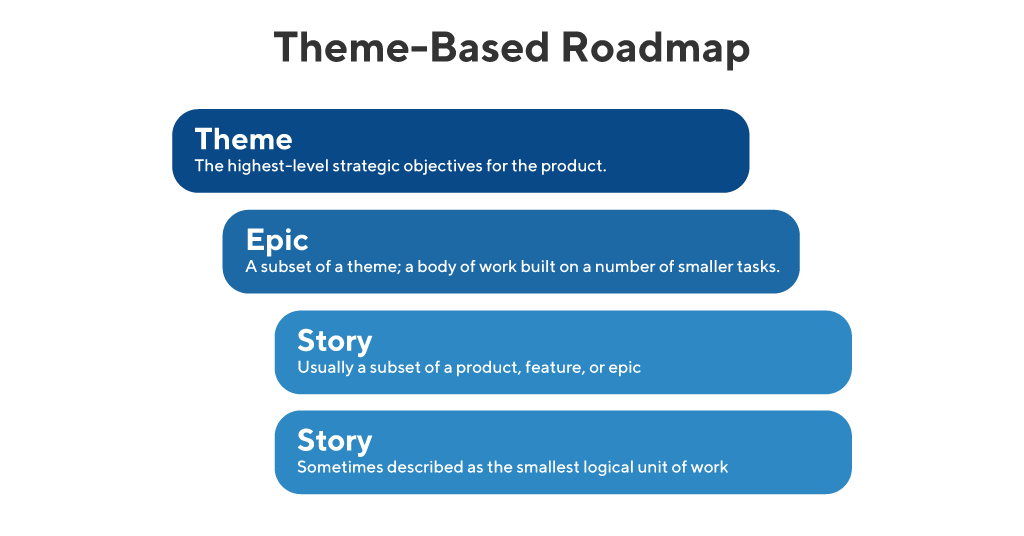What is a Theme-Based Roadmap?
With a theme-based roadmap, the product team groups its goals and plans into high-level strategic categories on the roadmap called themes.
Using this top-down approach, the team will prioritize, at most, a few major themes on its roadmap. Under each theme, the roadmap will include one or more epics (bodies of work to serve the theme). Each epic will consist of the relevant features and stories needed to complete that epic.
Why You Should Organize Your Roadmap by Themes Instead of Features
A roadmap should be a high-level blueprint of a team’s goals and plans as they relate to the product strategy. It should provide a clear and compelling answer to the question: Why should we build this product in this way?
Many product teams develop their roadmaps as a list of planned features. Structuring a roadmap according to themes offers more strategic advantages to a product team.
In our recent webinar, John Cutler, Jim Semick, and Abbie Kouzmanoff discuss the importance of feature-less roadmaps.
Here are a few other reasons to organize your roadmap by themes:

1. Roadmap themes help your team make better strategic and tactical decisions.
When you are developing your product’s roadmap, you need to start by answering several critical strategic questions. The specific questions will be unique to your company and circumstances, but here are a few examples:
- What are the major problems we can solve for our user and buyer personas?
- What two or three things could we do in the coming six months or year that will have the most significant impact on our bottom line?
- Have we identified any voids in the market that we can exploit to increase our market share or earn customers in a new industry?
When you turn the answers to those questions into a few major roadmap themes, you will have a clearer picture of the tactical details you will need to focus on in your product’s development.
Having these themes on your roadmap also gives your team a set of strategic guideposts during development. You can refer against these themes at any time to make sure you are still executing according to plan. You will also make more strategically sound decisions when you have to make adjustments to your plan.
2. A theme-based roadmap can help persuade your executives to green-light your plan.
We’ve worked with hundreds of product organizations around the world. Our experience tells us that executives prefer roadmaps that speak to high-level goals and outcomes, rather than those containing the team’s list of planned features.
Remember, a product roadmap should tell a compelling story about the future success of your product.
When you present your roadmap as a limited set of themes, your executives are much more likely to find your plan persuasive.
3. A theme-based roadmap leads to more successful products.
Structuring your roadmap into themes helps your team make better-informed strategic decisions throughout your product’s development. A theme-based roadmap can ultimately help your team build better products.

How do You Figure Out What Your Roadmap’s Themes Should Be?
As we stated above, a theme is a high-level strategic objective for the product. It could be a customer-centric business objective, such as increasing revenue or market share. Or, as Product Culture founder Bruce McCarthy describes it, a theme could represent “a high-level customer need,” such as improving the user’s onboarding experience.
OpenClassrooms suggests two strategies for finding strategically advantageous themes for your roadmap:
1. Determine themes from your product backlog.
A product backlog is a list of tasks, to-dos, and ideas relating to the product’s development.
When a product manager (PM) receives a request for new functionality from sales, support, customers, or anywhere else, the PM will place that item on the backlog. The backlog will also house the many ideas that come up during brainstorming sessions and other team meetings.
When trying to come up with themes for your roadmap, the product backlog is a good place to start your search. If your team has been updating it regularly, the backlog will have many ideas, requests, demands, complaints, etc. If you review the list carefully, you might find patterns or trends, and your research might find that addressing those trends could represent a worthwhile strategic endeavor.
2. Determine themes from your customers’ needs.
You can also go to your customers (or, if you don’t yet have customers, to your target users) for guidance on themes. Send out surveys, conduct extensive one-on-one interviews, look for clues in your product’s usage data, etc. Find out what your users care about and what problems they are most eager to solve, this is a great way to focus your strategic efforts and develop the major themes for your roadmap.
You gain valuable business intelligence by grouping and analyzing your customers’ pain points in systematically.
A superficial overview of your survey results or user interviews, for example, might reveal that several people have asked for the same feature. But a more careful examination of the data might also reveal this user persona represents a small subset of your target market. You will need to examine your customers’ feedback with the bigger strategic picture in mind before you develop your roadmap themes based on that feedback.
How Do You Present Themes on a Roadmap?
As ProductPlan founder Jim Semick explains, you want to present themes visually on your product roadmap.
Let’s use the screenshot below, taken from our product roadmap app, as an example:

This product team’s major strategic initiative is to improve the shopping-cart experience for its customers.
To turn that theme into more concrete and actionable work, the team has also added several epics: enhancing its website’s UX, for example, and adding support for its mobile site.
If we were to drill into these epics, we might find specific user stories to support them. For example, under “UX Enhancements,” we might see a story stating, “User can go from ‘Add to car’ to completing checkout in as few as three screens.”
Build Your First Visual Product Roadmap ➜
A Couple of Tips for Communicating Your Theme-based Roadmap to Stakeholders
Any effective product roadmap presentation should tell a story—a compelling story about your plans and expectations for the product’s future success.
Sharing a theme-based roadmap is no exception. Structuring your roadmap into major strategic themes should help make your presentation even more persuasive. Themes give you an easy-to-grasp hook for your story. With that in mind, here are a few tips for presenting your theme-based roadmap to stakeholders:
1. Explain your theme first
If you’ve drafted your theme-based roadmap properly, the other details on your roadmap will flow logically from your theme.So you’ll want to start your presentation by describing what the theme is. After all, it’s why you’re so enthusiastic about your plans and the reason you’ve invited these stakeholders to your presentation.
“I’m going to walk you through how we plan to improve our product’s trial-download process significantly, and the research suggesting this could have a real impact on our bottom line.”
2. Be prepared with data to support your claims and plans
Within those epics in the screenshot above, you also want to include a statistic or a link to research indicating the reason you’ve chosen to prioritize that work. You don’t need to plaster data all over the screen in your roadmap presentation. That will only clutter the presentation itself, confuse your audience, and undermine the power of your visually compelling, straightforward theme-based roadmap.
But with the right roadmap software, you can drop in the relevant research and statistics behind your main theme-based screen. This data will be just a click away when you’re ready to show it—or if a skeptical executive stakeholder demands evidence.




